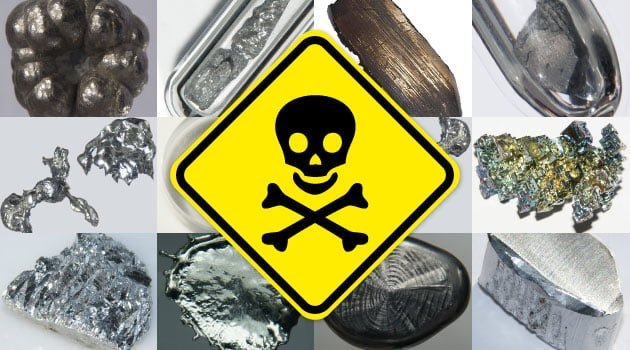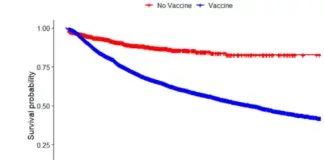
Detoxification is big news these days. From special drinks to diet programs, there are now ways to rid your body of a host of different toxins. Toxins can come from a variety of sources and understanding what you’re most vulnerable to and what the effects can be can help you identify toxins which may be affecting you and devise a plan to deal with them once and for all.
Heavy metals have been getting plenty of attention as we learn more about how and where our food comes from. The fact is that we’ve been exposed to these metals for years but we’re just now understanding how far-reaching their effects can be.
What Are Heavy Metals?
As its name implies, heavy metals are literally metal elements which build up in our surrounding environment. There was a time when we looked at heavy metal contamination only in relation to workplace exposure, such as men and women who were exposed to metal or arsenic as a part of their job. But today we know that heavy metal exposure can touch almost anyone’s life.
How Do Heavy Metals Build Up in Your Body?
For the general public, lead, cadmium, mercury and arsenic are the main areas of concern when it comes to heavy metal exposure and toxicity. All of these metals have been studied and researched by scores of researchers over the years. We have been using heavy metals for generations and while our understanding of their effects has grown, our dependence on them has only diminished by a small amount.
Lead exposure usually happens due to air pollution and some food exposure. Pollution from gasoline engines contains some lead particles which can affect people who live in urban areas, especially children. Children are particularly susceptible to this kind of exposure because of their permeable blood–brain barrier. This is why so many families choose to move away from the city once their children are born, though pollution can occur anywhere. Food sources for lead exposure come from food containers as opposed to the food itself. Glazed containers often contain traces of lead and this can be leached into the food itself.
Cadmium compounds are found in their highest concentration in cigarette smoke, making smokers and people who live or work alongside them one of the groups most likely to struggle with this form of heavy metal toxicity. Cadmium is also used in rechargeable batteries which has become an area of concern as more and more people turn to rechargeable batteries as a way to help the environment.
When most people think about exposure to mercury they think of old school thermometers and cavity fillings. Thermometers that use mercury are now a thing of the past and today dentists use different compounds to create fillings for cavities. But our exposure to mercury is more likely to occur when we eat fish which have been contaminated through living in polluted water. Tuna, swordfish and shark are all notorious for having high levels of mercury. So much so, in fact, that pregnant women are warned to exclude them entirely from their diet until their baby is born.
Exposure to arsenic happens through exposure from both food and water. Rice is the biggest food item that contains arsenic as the grain soaks up nutrients and toxins from the soil as it grows. Drinking water also often contains some levels of arsenic from the surrounding soil, but filtration is believed to keep it within safe levels. Over exposure to any arsenic no matter what its source has been linked to a variety of health concerns, including cancer.
How Can These Metals Affect Your Mental and Physical Health?
The physical and mental effects of these heavy metals have been studied and continue to be a source of research today. While researchers and clinicians are still working toward a better understanding of these metals, we know that exposure to heavy metals can contribute to general feelings of fatigue, mental fogginess and even serious medical conditions such as Alzheimer’s and Parkinson’s.
Symptoms of heavy metal toxicity can range from the mildly annoying to the downright serious. Some of the symptoms worth looking at in connection to heavy metal exposure include:
Nausea or vomiting even though you don’t feel ill
Increased sweating
Chronic headaches
Respiratory problems
Muddled thinking
Difficulty with communication (struggling to find the right word)
Chronic fatigue
Digestive concerns
Depression
Reproductive problems (primarily for women – this includes irregular periods, miscarriages, infertility and premature birth)
Heavy Metal Detox – What You Need to Know
With metals being implicated in so many health problems, detoxification has been touted as a virtual panacea. But the truth is that not all detox options are right for all people. As with any form of personal improvement, these detoxes should be researched carefully and then considered against any present health concerns.
Detoxification products are well worth researching but for those who want to begin right away, there are some completely natural and preventative steps we can take. These options address not only ways to avoid heavy metal exposure, over time they can also begin to clean the body out and work as a slower, natural form of detoxification.
Go Organic – Eating organic foods will help you to avoid the heavy metals which can occur as a result of pesticide use.
Eat Clean – Forget the processed foods and go back to whole foods options. That means no more refined sugar, skipping the drive-thru at lunch and opting for dinners made at home.
Raw for Life – Experts recommend making roughly one-third of your diet raw. If this seems like a lot, it’s worth exploring the new options available through raw recipes. With raw and paleo diets so popular there are now recipes for everything from raw vegetable noodles to use in place of traditional pasta to raw versions of cheesecakes.
These simple guidelines are easy to incorporate into any diet and they can improve a person’s overall health while laying a foundation to detoxify and cleanse the body of all kinds of toxins – including heavy metals.
As we gain a better understanding of how heavy metals affect us both mentally and physically, we also gain a sense of urgency when it comes to detoxification. By taking simple steps towards healthier eating and using detox products wisely, we can help to improve our health and protect our brains for years to come.
About the Author
Laura Halliday has been coaching couples to a better, more holistic, natural and guilt-free sex life for three years. She currently resides in Seattle where she continues to read and write about psychology, emotional and physical health and relationships. Please visit her website.
Disclaimer: We at Prepare for Change (PFC) bring you information that is not offered by the mainstream news, and therefore may seem controversial. The opinions, views, statements, and/or information we present are not necessarily promoted, endorsed, espoused, or agreed to by Prepare for Change, its leadership Council, members, those who work with PFC, or those who read its content. However, they are hopefully provocative. Please use discernment! Use logical thinking, your own intuition and your own connection with Source, Spirit and Natural Laws to help you determine what is true and what is not. By sharing information and seeding dialogue, it is our goal to raise consciousness and awareness of higher truths to free us from enslavement of the matrix in this material realm.
 EN
EN FR
FR


























The Klinghardt Neurotoxin Elimination Protocol did work for me.